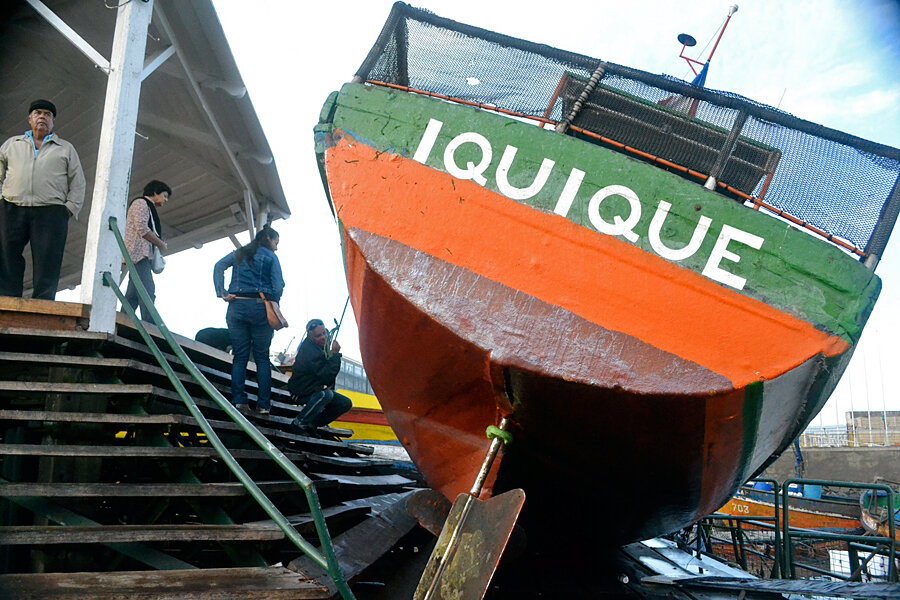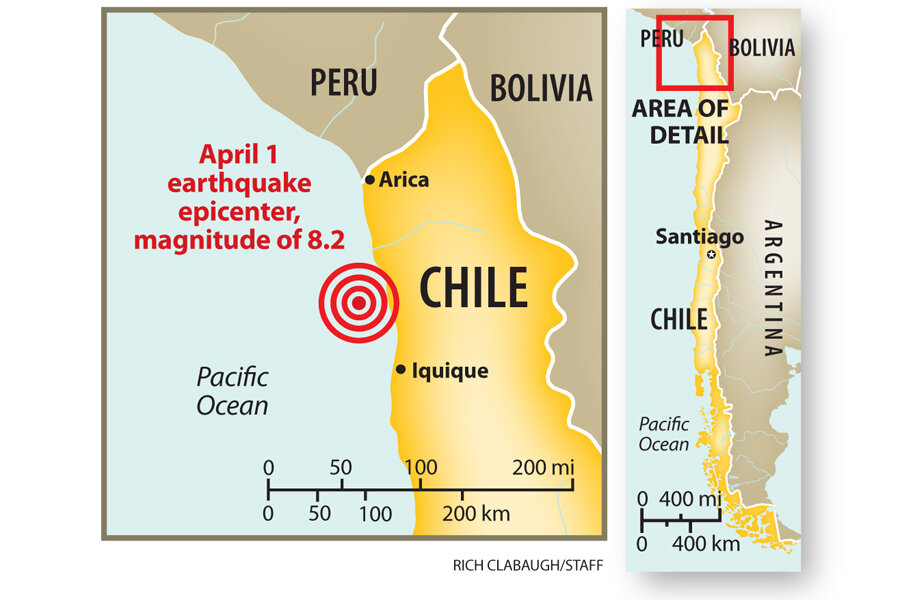Chile earthquake: Is the 8.2 temblor only a foreshock?
Loading...
Chilean officials are assessing the damage after a magnitude-8.2 earthquake struck the country's north coast Tuesday night, leaving at least six people dead, triggering landslides and fires, and cutting off electricity to thousands of residents.
The temblor was centered some 42 miles offshore and 59 miles northwest of the port city of Iquique, home to 182,000 people. People reported shaking as far south as Antofagasta, another coastal city nearly 240 miles from Iquique, to La Paz, Bolivia, some 300 miles to the northeast of the port. Towns in southern Peru also reported shaking from the quake.
The event struck along a 7,000-mile-long boundary between two plates in the Earth's crust – the Nazca plate beneath the eastern Pacific Ocean and the South American plate. The Nazca plate is sliding underneath the South American one at an average rate that ranges from three inches a year along its southern half to 2.6 inches a year along its northern extent.
While the quake was large by any measure, seismologists remain concerned that it could have been a foreshock to a much larger quake that could strike this region – a section of plate boundary that hasn't seen a major rupture in 137 years.
The small number of fatalities reported so far can be traced to several factors, according to Rick Allmendinger, a Cornell University geophysicist who has conducted extensive research in the affected region.
Although the quake affected a major port city, the region as a whole is sparsely populated. And while the quake generated a tsunami, the highest reported tsunami along the coast was a seven-footer that reached Iquique. Had the quake occurred beneath deeper water, the tsunami could have been much larger, Dr. Allmendinger says.
In addition, Chile has seismic building codes "that are top notch," he says, and that are enforced. "Chileans take those things seriously."
Also, over the past few years, the government has held several planning exercises to hone evacuation and emergency-response procedures.
"These planning exercises make a big difference" in preparing people to take the appropriate action when a big quake hits, Allmendinger says.
Chile and other countries along South America's west coast are no stranger to large earthquakes. The subduction of the Nazca plate beneath the South American plate has given rise to the Andes Mountains, the spectacular chain that hosts a large number of volcanoes as part of the Pacific's Ring of Fire.
The quakes along subduction zones tend to be more powerful than quakes along faults such as California's San Andreas one because subduction ruptures involve faults that have much larger surface areas along which stress can build, so they release more energy when they snap. And the segments that rupture tend to be relatively shallow, between six and about 40 miles deep, according to the US Geological Survey.
In May 1960, the most powerful quake ever recorded struck offshore near Valdivia, Chile. At magnitude 9.5, the quake released some 90 times the energy released by Tuesday's quake. Tsunamis up to 82 feet tall hit Valdivia and other areas along Chile's southern coast.
Tuesday's quake struck a 300-mile section of the plate boundary known as the Iquique seismic gap. The last quake to occur in this gap ruptured it in 1877.
Seismologists have known for decades that this section of the plate boundary was due for action in the relatively near future, says Cornell's Allmendinger.
In fact, Tuesday's quake was preceded by a magnitude-6.7 quake about two weeks ago "with a lot of little, what we thought were then, aftershocks," he says. "It turns out that those were the foreshocks" for Tuesday's rupture.
The temblor Tuesday struck a small segment of the gap. If the entire segment were to snap all at once, it would produce a much bigger quake, he explains.
Indeed, "one of the possible scenarios that we're monitoring right now is that it is still possible that the earthquake we had last night is actually a foreshock to a much bigger earthquake," he says. "For the sake of our Chilean friends, we hope that it doesn't happen."







